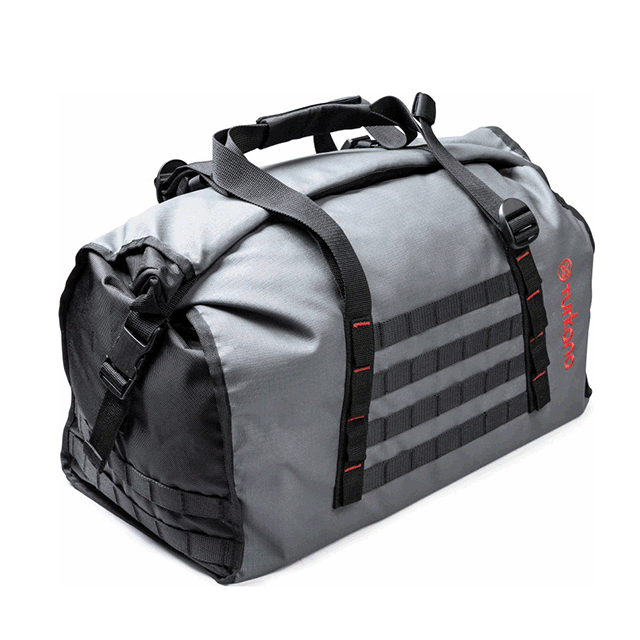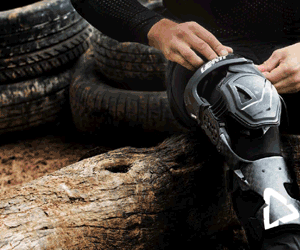The biggest Adventure riding buzz at this year’s show has been around the newly launched production-ready models at KTM’s stand. With a redesigned KTM 690 Enduro R, new graphics for the KTM 1090 Adventure R, KTM 1290 Super Adventure S, and KTM 1290 Super Adventure R, and not forgetting the newly developed youth orientated KTM SX-E 5. It is, however, the long-anticipated 790 Adventure series that got most social feeds buzzing. The 790 Adventure is slated as a “travel enduro” by the orange blooded manufacturer. Weighing in at 416.7 lb / 189 kg the new Ready To Race offering is set to be a “lightweight, agile and technically advanced machine” that should put a smile inside riders helmets. Both the Adventure R and Adventure are powered by the same 95 hp, 799cc LC8c parallel twin engine, first seen in the KTM 790 Duke. However, it has been specially tuned to deliver its torque lower down the rev range. Other engine refinements include dual balancer shafts, a Power Assisted Slipper Clutch, and a Ride-by-Wire throttle. Also of note for the engine is the 9,320 mi / 15,000 km service intervals as recommended by KTM.

The Adventure R itself is set apart from it’s only slightly more mild-mannered sibling by longer travel suspension, Karoo 3 dirt tires, a non-adjustable one-piece seat, shortened windscreen and modifications to the bodywork. However, that is where the differences end. Both feature the same light tubular Chromium Molybdenum steel frame that uses the engine as a stressed member. This, in turn, reduces the overall size and brings the weight down. The suspension comes in the form of 48 mm WP XPLOR front forks with 240 mm of travel for the R and a 43mm APEX open-cartridge front fork set with split function technology on the base model. The rear shock is a WP APEX shock absorber with adjustable preload that makes it ideal for traveling fully loaded over adventurous terrain. The R, in turn, features a WP XPLOR PDS rear shock with a progressive damping system. This allows progressive damping without the use of linkage which reduces weight and maintenance. The Adventure R boasts 9.4” / 24 cm of travel, and 10.4” / 26 cm of ground clearance over the Adventure’s 7.9” / 20 cm of travel front and rear along with its overall ground clearance of 9.2” / 23 cm.

On both models, the front wheel is a 21” number stopped by two radially mounted four-piston calipers that run on a set of 320 mm discs. The rear 18” being stopped by a single two-piston floating caliper clamping down on a 260 mm disc. Seat height comes in at the 34.6” / 880 mm mark. With the Adventure model boasting a slightly more comfortable looking adjustable split seat option. The low-slung fuel tank ensures a low center of gravity and more natural rider movement giving both models a Dakar winning rally style look. Fuel capacity comes in the volume of 5.3 gal / 20 L tank that is pegged to provide a practical range of 280 mi / 450 km.

As hoped the electronic goodies on both models include engine braking technology, tractions control, and cornering ABS. Off-road ABS only for the front wheel is also standard across the board. The display is a full-color high visibility TFT unit that is programmable based on the rider’s preference and adjusts to ambient light conditions. It offers smartphone integration, cruise control, along with access to Street, Off-Road, Rain and a very intriguing Rally Rider mode. Assumably KTM’s answer to BMW’s Enduro Pro mode. Stylistic differences include a dual sports style front fender on the R while the Adventure features a classic hugging front mudguard. Added personal rider comfort is achieved by the ability to mount the tapered aluminum handlebar in six different positions giving a 1.1” / 30 mm range of adjustability. Optional equipment for both models should include heated seats and grip, cruise control and an OEM range of luggage options.

With both bikes developed in conjunction with some of the best adventure riders in the world and the Red Bull KTM Rally Factory Racing Team, we can’t help but ask; where do we sign?

The production-ready Ténéré 700 traces its heritage back to the XT 500 launched in 1976. An instant success amongst adventure-seeking riders that saw 60 000 units sold in France alone during its fourteen years in production. With one of it’s most notable achievements being the unit that Cyril Neveu piloted to victory in the first Paris-Dakar Rally. It was on this heritage that Yamaha built when they first unveiled their T7 concept at EICMA in 2016. Two years have passed with several semi re-boots, in a matter of speaking, since then. Most notably the 2017 Ténéré 700 World Raid prototype with its subsequent globe-trotting tour. However, this year’s show saw the final unveiling of the production-ready model.

Most notably the new Ténéré 700 features a surprisingly narrow body with a slim fuel tank, and flat seat that gives it a more compact look and feel when compared with other offerings in the same range. At the heart of this “lightweight no compromise Adventure model” lies Yamaha’s CP2 689cc parallel-twin, liquid-cooled, DOHC engine borrowed and slightly reinvented from the MT-07. Official figures list the power-plant producing 73 hp which for many has unfortunately been a disappointing figure. The engine is carried in a high-strength and lightweight tubular steel frame that “provides a tuned rigidity balanced for nimble, responsive handling and the strength and durability needed to tackle the harshest terrain with confidence.”

The wheelset is a 21” / 18” combo that allows for a wide range of off-road biased tires. Fitted standard though is the Pirelli Scorpion Rally STRs. Yamaha also has thought ahead and installed a Switchable ABS system that allows for safe on-road commuting while giving full control for off-road use. A nod to its Rally heritage this is an interesting move when so many other manufacturers aren’t giving full ABS control to riders. The front suspension is supplied by a set of fully adjustable long-travel 43mm upside-down telescopic forks with 8.3” / 21 cm of travel. The rear features a linkage-type shock with 7.9” / 20cm of travel. It also features a remote preload adjuster to personalize ones setting based on the ground covered or load carried. All of this combines into a seat height of 34.6″ / 879 cm with a wheelbase of 62.6″ / 160 cm and a 9.5” / 24 cm ground clearance. According to official numbers the compact 4.2 gal / 16 L fuel tank allows for a fuel range of over 215 mi / 350 km. The cockpit features a lightweight display panel showing gear position, fuel level, two trip meters, and the estimated fuel range, as well as average and instant fuel consumption. Also specifically integrated is a dedicated mounting bar for accessories such as a GPS or Road-book. Covering all this is a true Dakar style clear Rally fairing or “nacelle” that houses the four aggressive looking vibration resistant quad LED headlights.

Yamaha has promised the European market a showroom arrival for late 2019 but unfortunately neglected to prioritize North America. Delaying delivery in one of the biggest markets by a vague two years. The official Yamaha Motorsports website for the USA listing availability as “the second half of 2020.” One can only wonder about this move from the Japanese motorsports powerhouse. Especially since the stir their social media campaign created, with many customers having asked where they could put their money down in the run-up to this week’s unveiling. With so many other manufacturers bringing medium weight Adventure options to the market we hope that these prospective clients won’t put their money elsewhere.

The Bavarian manufacturer’s flagship offering at this year’s show is the new GS Adventure based on the upgraded shift cam technology R1250 platform launched at INTERMOT. The new platform not only offers better emission control in the strict EU regulations sphere but also ups the fuel efficiency, power, and torque. Especially in the lower engine speed range where it’s needed when tackling off-road adventures. Essentially this boils down to the shift cam technology enabling variation of the valve timing and valve stroke on the intake side. Giving BMW the ability to merge the power delivery of two differently set up power-plants into one unit. Along with this, the intake camshafts are also designed for an asynchronous opening of the two intake valves, resulting in an enhanced swirl of the incoming mixture that produces more effective combustion. Other changes to the engine include a toothed chain instead of a roller chain driving the new camshaft, optimized oil supply, twin-jet injection valves, and a new exhaust system. All of this get’s the power up to the 136 hp mark.

BMW has also included some new electronic wizardry into the model with it’s Hill Start Control, and Automatic Stability Control (ASC) offered as standard. Both of these are rider assist modes and should help less experienced riders gain some confidence on the 591 lb / 268 kg beast. Along with this a plethora of new Pro riding modes are also available as optional extras. Another optional extra of note is the BMW Motorrad eCall system. An “Intelligent Emergency Call” system which aims to get first responders to your location faster in the event of an emergency. Color variants include three options; Style Exclusive, blacked out with a grey frame, olive metallic tank, and gold calipers. Ice Grey featuring black wheels, chassis, and powertrain, with silver / gray tank and bars. HP with a white frame, black subframe, gold wheels, single unit seat along with blue, white and red livery. Fuel carrying capacity has been increased to 7.9 gal / 30 L along with some tweaks to the lower and upper crash bars, molded skid plate and a rear rack that comes standard on all models.

In 2018 the growth in sales of Honda’s European 125 cc offering saw a twenty-five percent hike in the market. Coupled with Honda’s habit of showing off concept bikes at EICMA that tend to make it to market, there are high hopes from the Adventure riding community that their latest concept might make it into showrooms. Case in point the True Adventure concept, that after wide community praise made its appearance as the Africa Twin Adventure Sports. Enter the CB125 X concept designed by the Japanese giant’s European research and development center, shown at this year’s event. The small bore adventure machine is based on the existing CB125R’s engine and frame but with a sharp rally-bred look and feel. This might prove to be an invaluable entry level machine to the adventure market for less experienced or cash conscious riders. The platform features a dirt ready front wheel, spoked rims all round, long travel suspension, spartan cockpit, aluminum tapered bars, wrap around hand guards, and a true slim rally style seat.

With a modern angular design, the X looks focused on getting riders onto gravel roads and exploring. A tall screen protects the rider while allowing a clear field of vision. Below this, a cluster of LED lights makes up the headlight in a futuristic package. Side panels on the bodywork look to be replaceable in the event of a drop. With the front hugger mudguard hovering just far enough above the front wheel to facilitate fitment for fully dirt focused tires. The upside down forks also features a beefy duo of protectors that integrate with the hugger. The SC Projects exhaust is also a nice touch and hints even more at potential showroom availability. First glance at the fuel tank confirms suspicions that range won’t be an issue on such a go anywhere bike. Below the molded bodywork sits a large wrap around skip plate that will affirm any potential gravel crunching dreams of those that would like to see this motorcycle parked up in their garage. Sooner rather than later.
All images copyright of the respective manufacturers.





Leave a Reply